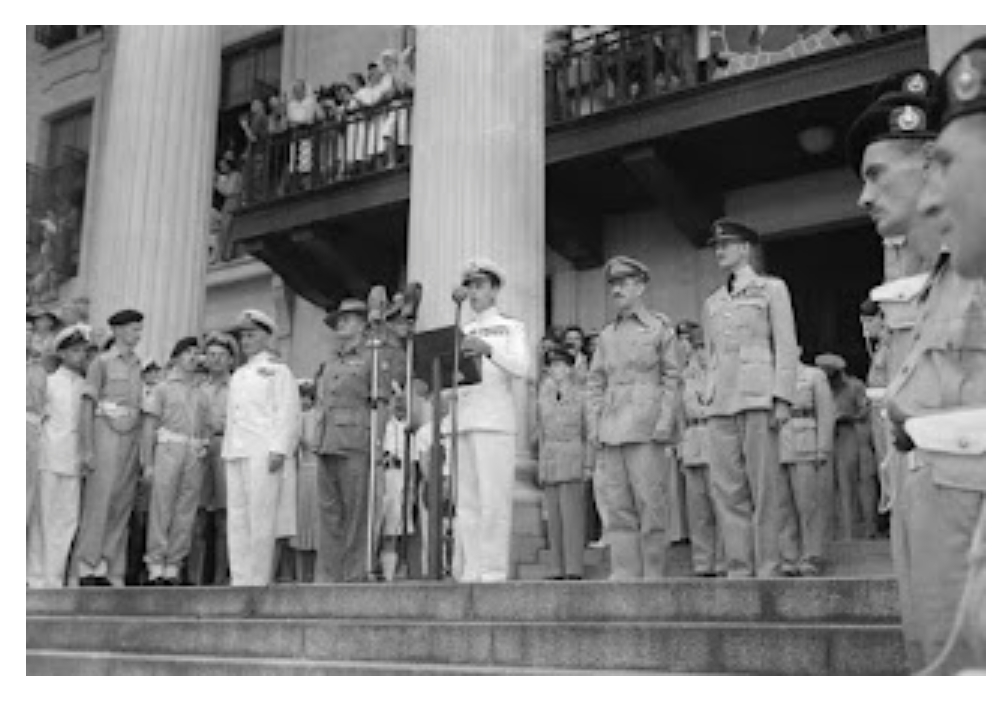
Unlike the surrender of Nazi Germany, which took place on 7 May 1945 to little fanfare in a French schoolhouse in the middle of the night, the bringing about the official surrender of Japan, which took place on the American battleship Missouri on 2 September 1945, was a spectacular event steeped in pageantry and witnessed by thousands ranging from high-ranking dignitaries to common enlisted servicemen. During these proceedings, the Japanese Foreign Minister Mamoru Shigemitsu signed the official instrument of surrender.
American General Douglas MacArthur then signed the document on behalf of the Allied nations followed by other signatories representing the individual members of the Allied coalition. This included Admiral Chester Nimitz for the United States, Admiral Bruce Fraser for the United Kingdom, General Thomas Blamey for Australia, Air Vice Marshal Leonard Isitt for New Zealand and Colonel Lawrence Moore-Cosgrove for Canada.
Among the throng present at this momentous event were British Lieutenant-General Arthur Percival and American Lieutenant-General Jonathan Wainwright. Until very recently, both men had been prisoners of the Japanese, the former having surrendered at Singapore while the latter surrendered at Corregidor in the Philippines.
During the ceremony, both men stood directly behind General Douglas MacArthur when he signed the surrender document on behalf of the Allied nations. During this process, MacArthur used six pens, two of which he gave to Wainwright and Percival.
The presence of these men and this act had great symbolic significance as it reflected the miraculous and definitive turn of events that had occurred over the previous three and a half years. Early in the war, Japan had inflicted the worst series of military defeats ever to befall the United Kingdom and the United States. Both Generals Percival and Wainwright had been key participants and witnesses to these earlier events in which Japan appeared almost invincible.
Now, like a phoenix rising from the ashes, both men emerged from this bleak period and years of horrendous Japanese confinement to witness Japan’s downfall as it acknowledged a defeat of far greater magnitude.
Following this same theme, ten days later the British carried out a similar ceremony in the Singapore Municipal Building where General Seishirō Itagaki surrendered all Japanese forces in Southeast Asia to Admiral Louis Mountbatten. Accompanying Mountbatten on this grand occasion were many of the key leaders who had prosecuted Britain’s war effort within the region.
Amongst these was Lieutenant-General William Slim, the indomitable commander of the Fourteenth Army; Admiral Arthur Power, the commander of the East Indies Fleet; and Air Chief Marshal Keith Park, the Allied Air Commander South-East Asia Command. Following this ceremony, the British conducted a celebration and victory parade in Padang.
Singapore had been the scene of Britain’s humiliating surrender some three and a half years earlier, which had culminated the disastrous Malaya campaign in which the British had given up some 130,000 prisoners. Now with the culmination of these actions, the British regained control over their lost territory and secured the surrender of some 633,000 Japanese military personnel thus once again seeing events turn full circle.
Pictured here is the surrender ceremony in Tokyo Bay. Directly behind a seated General MacArthur are Generals Wainwright (left) and Percival (right). Also visible is General Blamey (the first full person on the left). Cross, W. G. (Sub Lt), Royal Navy official photographer, public domain. The second image shows Admiral Mountbatten (speaking) flanked from left to right by Admiral Power, General Slim, American Lieutenant-General Wheeler and Air Chief Marshal Park during the surrender ceremony in Singapore. Ashley (Fl Off), Royal Air Force official photographer, public domain.


For a comprehensive accounting of the spectacular series of events that brought about these outcomes, see Forgotten War, the British Empire and Commonwealth’s Epic Struggle Against Imperial Japan, 1941-1945.










Leave a Reply